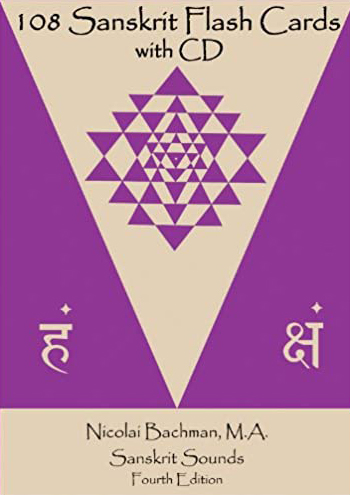Yoga is one of those things that grows on you. When you take your first yoga or meditation class, you don’t fully know what to expect. But a seed is planted. And that seed, when nourished, grows into a beautiful tree that sustains you for the rest of your life. A great way to nourish your yoga-tree is to learn a little Sanskrit—the language of yoga.
Don’t let me scare you off with this suggestion! You probably already know several Sanskrit words. Your hatha yoga teacher might use traditional posture names like vīrāsana or śavāsana. And some words, like karma, mantra, or even yoga itself, have become commonplace in English.
Read on and see how you can increase your pleasure and appreciation of the Sanskrit language.
Why Seek Perfect Pronunciation?
Perfection is at the very heart of Sanskrit. Great care was taken to preserve its integrity over the years. Ancient scholars and sages developed strict rules for Sanskrit grammar and pronunciation. Students began their studies at a very young age under the watchful eyes of their masters. They were drilled carefully. This assured that texts were passed on accurately to future generations.
Yogic mantras, energy-charged words or phrases, are also passed down from Guru to disciple. Mantras are important tools along the path to enlightenment. They must be repeated with precision to achieve their powerful effects. As serious seekers we want to avoid missing the goal by mispronouncing a mantra.
You might have heard Sanskrit called the language of the gods. I’ve always appreciated this sentiment. It’s given me a sense of awe for the language—just as I respect the Divine. The idea of speaking “God’s language” increases my reverence for it. I don’t want to bungle it.
It’s now common practice for hatha yoga teachers to use Sanskrit in their classes. They refer to terms, posture names, mantras, and chants. By careful attention to pronunciation, we can better understand and appreciate the terms our teachers use.
Why Devanagari Helps Your Pronunciation
Original Sanskrit scripts look very little like the text you’re reading now. In fact, the sounds in Sanskrit are represented in many different scripts. This is possible because it’s a phonetic language. Today, the most common Sanskrit script is Devanagari.
Phonetic languages are easy to read once you learn the script. For example, when you see the letter स in Devanagari, you would only pronounce the sound sa (like in sun.) Unlike the English pronunciation of sa (as in same or sand), the Sanskrit sa never deviates.
There have been many attempts to convert Sanskrit into text that’s easier for English speakers. This effort is called transliteration. In the long run, however, using transliteration instead of Devanagari hinders your progress. It allows you to fall back into old habits of English pronunciation. This happens very quickly and without your noticing it.
Perfection of Sanskrit begins with learning the Devanagari script. This is not as difficult as it sounds and has some side benefits such as being good brain exercise.
Start Learning Devanagari
If you were born in India—lucky you! You’ve got the head start we Westerners envy. Your parents trained you from birth to pronounce the sounds used by many Indic languages like Hindi.
However, most native English speakers didn’t receive that early training. We need to start learning the language like kindergarteners. First, we must learn the alphabet, understanding how to form Sanskrit sounds. After that, we’re ready to start reading whole words.
Many online resources are available to help you learn the Sanskrit alphabet. I recommend starting with these YouTube videos: “The First Sanskrit Lesson-Mastery of Sound” and “Learning Sanskrit Part 1: Vowels.” These videos show the Devanagari script. They also instruct how to properly make the letters’ sounds.
Practice Leads to Success
Practice is the key to improving your Sanskrit pronunciation. Let your Sanskrit study include all your sense organs. Here’s how:
- Eyes: Watch the videos recommended above. Carefully observe the forms of the letters. Notice the difference between different computer-generated fonts as well as handwritten letters.
- Ears: Listen only to the best Sanskrit pronunciation available. On YouTube, you can slow the speed of any video. Listen first at 50% speed, and then increase the speed as your hearing improves. Repeat what you hear. Record yourself, and then play back your recording, while listening for accuracy.
- Hands: Write the alphabet often—until you can do it from memory without mistakes. Using your best handwriting, practice writing the alphabet. Once mastered, you can practice writing familiar Sanskrit words. Additionally, it helps to speak the words aloud as you write.
- Mouth: If you’re new to Sanskrit, you’ll be surprised to learn about the importance of your vocal organs. You must learn to form the letters properly. Those students who choose to ignore this point can never sound authentic. And other Sanskrit speakers won’t be able to understand them.
- Nose: I confess that this advice is a bit of a stretch—try using a favorite incense or aromatherapy during your Sanskrit study sessions. Your brain’s association with pleasant smells helps the learning process—and makes it more fun!
Recommended Resources
The principle of keeping good company applies to your Sanskrit studies. Choose the best Sanskrit resources, and your pronunciation will quickly improve.
Sanskrit teachers now proliferate on the internet. It might seem easier to learn from a native English speaker. However, in my experience, I’ve benefitted more from my Indian-born teachers. Their pronunciation is inherent in their speech. As mentioned earlier, they learned it from their parents. Your own pronunciation is bound to be more authentic by listening to Indians.
The good news is that it’s no longer difficult to find good Sanskrit instruction. Several online courses are available. Most importantly, examples of excellent Sanskrit can be easily found on YouTube.
Following is a list of chants that I recommend. These will help you hone your listening skills.
Let’s strive together to perfect our Sanskrit pronunciation. Do you have any favorite Sanskrit chants or references to recommend? Please include links in the comments section below.
Chityānanda has been a disciple of Svāmī Gurupremānanda Sarasvatī since 1975. She teaches meditation and yoga as a spiritual path in Santa Cruz, California.



This is a good and informative article. I plan to get the flash cards when I am able to. I don’t have the recordings or the chants written in Sanskrit. It would be nice to get those. But meantime I do enjoy practicing singing the chants I do have. Thank you Svami for your constant encouragement to remain steadfast in the practice of Sanskrit.
Greetings, Nakisa. You won’t need the cards one you’ve memorized the Sanskrit alphabet. Vyoma Labs offers a free app that teaches the Sanskrit alphabet, so if you download that and use it a few times you’ll be on your way to reading whole words easily. Namaste.
Besides the Guru Gita, I get inner stirring from the PĀDUKĀ-PAÑCAKAM. I love this chant, it is a chant of the power, grace and blessings of the Guru’s sandals.
Thank you for your comment, John. Those are two very powerful chants that you mention. The App Store has an app called “Guru Gita.” It shows the Devanagari and highlights the words as the chant progresses. It’s very helpful for those learning to read Sanskrit. Additionally, The Sanskrit Channel on YouTube has a very nice 3-part explanation guide for the Guru Panchakam chant that you mention. These are two very good references that you might enjoy. Namaste.